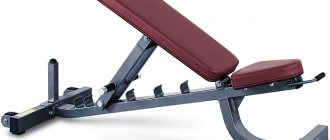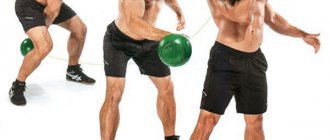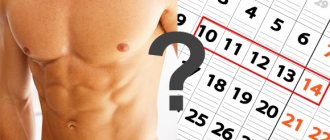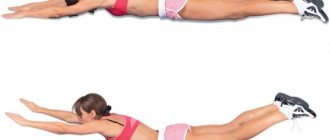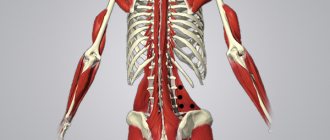Home ▸ Articles ▸ Workouts ▸ Professional exercises and chest workouts at home
If you can't go to the gym right now due to the pandemic or other reasons, your main chest workout option is push-ups.
Push-ups may not be as sexy as dumbbell presses and barbells for building chest muscles, but they work more muscles throughout the body and are much less harmful to shoulder and elbow health in the long run.
It's easy to give up on push-ups if you only know one way to do them, which is the way you learned in gym class (hands shoulder-width apart, down and up). If this is the only type of push-up you've done for decades, of course you're bored.
But now you'll learn some more challenging and fun variations of push-ups that will renew your respect for the world's oldest chest exercise. For those who have a pair of dumbbells, there is also a chest workout for a more isolated swing.
Benefits of Chest Training
Let's start with the obvious: big pecs are awesome. In a 2021 study, 160 women rated men with large chests and arms as the most physically attractive using photographs.
Scientists speculate that the reason lies in evolution: stronger, more capable-looking men were more likely to protect and provide for women in pre-civilized, primitive times, but women still tend to appreciate this aesthetic today.
The pectoralis major muscle is the pectoralis major muscle and has four functions. The pectoral muscles help raise the arm in front of the body, lower it back to the side, move the arm across the front of the body, and rotate the arm inward toward the midline of the body.
Thus, strengthening the pectoral muscles helps with a variety of athletic functions, from pushing and throwing to climbing and punching. Variations of the bench press as well as push-ups are used in almost all football strength and conditioning programs as they can help the linesman push an opposing player back off the field. Swimmers use their chest muscles constantly during movements such as breaststroke and backstroke.
Anatomical information
The chest is a whole set of muscles of varying sizes. Since in the human body they are second in volume only to the back and legs, chest exercises are one of the three main types of exercises. The anatomy of the pectoral muscles is that they include 2 main groups: the minor and major muscles, as well as a number of additional ones (coracobrachialis, serratus anterior, etc.). The entire sternum is divided into zones:
- top;
- average;
- lower
There is also a division of the pectoral muscle into internal and external parts. But for chest exercises, this division is not particularly important. The harmonious development of the pectoral muscles requires the use of a whole set of exercises that should take into account the main function of this muscle group: bringing the arm towards the body and turning it inward.
How to pump up your pectoral muscles without weights?
If you don't have the training equipment but want to tone your chest, you'll have to make friends with push-ups (and their many variations). Watch how this is done and you will see that it is essentially the same movement as the bench press, only you are not resting on a bench.
The bench press allows you to work your pecs with more isolation and heavier loads. This is beneficial for building muscle mass, but it also has its disadvantages. The harder you press, the more weight you have to use and the more stress you put on your shoulder joints.
Push-ups can be made more challenging by adding weight using weight vests or simply performing the movements in more difficult or unstable positions. Push-ups allow your shoulder blades to move naturally, which they cannot do when resting on a bench during a bench press. And it provides added stability, so even when you're training for heavy push-ups, they're not as dangerous as the press.
Most weightlifters complain of shoulder pain at one time or another, but have you ever heard of someone hurting themselves while doing push-ups?
Push-ups are what are called closed-chain exercises. Your hands rest on the floor instead of going up. This requires more muscles throughout the body to provide stability during movement.
The bench press primarily targets your pecs, deltoids, and triceps, but push-ups will work all of those, as well as your core, upper back, and legs. It will also affect them in the same way as movements in everyday life and sports.
You'll rarely or never have to push something heavy off your chest while lying on your back on the ground, but if you expect to be trapped under a log one day, the bench press is sure to prepare you for that situation.
Ultimately, research shows that an exercise's muscle-building potential comes down more to effort than load. Push-ups can be just as effective for chest growth as heavy presses, provided you take your sets to (or close to) failure.
In a 2021 study from McMaster University in Ontario, subjects trained with either light or heavy weights, and both groups achieved the same muscle gains after 12 weeks. The light weight group used just 30% of their maximum weight—which may be similar to the effect of a bodyweight push-up compared to a heavy bench press—and still made progress.
Meanwhile, a 2021 study found that people who performed bodyweight exercises improved body composition comparable to those who performed weight-bearing exercises. The point is that your muscles don't know whether you're lifting a barbell, a dumbbell, or your own body. Follow all the rules of building muscle by training it hard, often, gradually, from different angles and with different training methods, and they will respond by growing.
About the importance of pumping the pectoral muscles
The pectoral muscles include two main muscle groups.
These are the pectoralis major and minor muscles. The latter are located under the larger ones and, as can be understood from their name, are smaller in size. Since the fibers of the chest muscles extend in different directions, several muscle regions are distinguished among them - internal, external, upper and lower. Inflated pectoral muscles generally develop the chest adjacent to the lungs. By pumping your chest muscles, you will not only make them stronger and more impressive in appearance, but also create additional space for your lungs and improve the breathing process. Evidence of this are outstanding bodybuilders with powerful chests, demonstrating the strength of the chest in the aggregate and deep breathing.
Doing strength exercises with your own weight
, it should be borne in mind that different parts of the chest will be simultaneously involved and, depending on the specific exercise to strengthen the muscles, the load on them will be distributed differently.
Home exercises and chest workouts with and without weights
What follows are two workouts developed and demonstrated by American trainer Larry Maloney (@luminary_larry). One requires only your body weight, while the other can use almost any pair of dumbbells.
Bodyweight Chest Workout Scheme
This program combines chest work with circuit core training, so by summer your abs will be as prominent as your chest. You'll alternate between straight chest exercises and push-up variations with movements that force you to engage your core muscles to maintain good body alignment—a feat when you're moving your limbs quickly.
Note that there really is no rest for the chest until the end of the cycle, so even as you train your abs, your pectoral muscles will contract to stabilize your arms and shoulders.
What you can do is guarantee that your pecs will be just as toned and tender as if you were doing a heavy ab workout, but with a routine that takes less than 15 minutes to complete.
Directions : Perform the exercises in a circuit, performing one set of each in sequence, with no rest in between (or, if absolutely necessary, rest as little as possible).
After this, rest for 2 minutes and repeat the cycle for 4 rounds. Unless otherwise directed, do 10 reps for each exercise on the first circuit. Reduce the number of reps by 2 in each round, so you'll do 8 reps on the second round, 6 reps on the third, and 4 reps on the fourth.
Scorpio push-up
Step 1: Get into a push-up position with your hands shoulder-width apart. Slightly bend your pelvis perpendicular to the floor and tense your core. Your body should form a straight line from head to toe.
Step 2: Lower yourself until your chest is about an inch above the floor. Lift your body back and then lift one leg off the floor. Continue pressing into the floor and pushing your hips back until your arms are directly above your head. Return your leg to the floor, do another push-up, and repeat with the other leg. Each push-up counts as one repetition.
Cross Climber
Reps: Do 20 on the first round, then 18, 16, 14.
Step 1: Get into a push-up position and lift one knee toward your chest. As it rises, rotate your hips to bring it closer to your opposite elbow. Try touching your elbow.
Step 2: Turn back and repeat on the opposite side. Each knee touch counts as one repetition.
Alligator Push-Up
Step 1: Get into a push-up position and lower your body toward the floor while lifting one leg to the side with your knee bent.
Step 2: Push back and return your foot to the floor. Repeat the push-up and lift the opposite leg. Each leg raise is one repetition.
Side Climber
Reps: Do 20 on the first round, then 18, 16, 14.
Step 1: Get into a push-up position with one knee bent 90 degrees under your chest. Extend your other leg straight out to the side.
Step 2: Switch legs, bringing your right knee under your chest. Continue to quickly shift back and forth while staying light. Try not to twist your shoulders and hips, tightening your core. Each switch is one repetition.
Beast Push-Ups
Step 1: Get into a push-up position and push your hips toward your heels while extending your arms overhead (beast position). Don't let your knees touch the floor.
Step 2: Extend your legs and pull with your arms to return to a push-up position, then perform a standard push-up. Press back as you return straight to beast position. Each push-up is one repetition.
Training program for the pectoral muscles at home
The classic option is a split, in which the chest is pumped once a week together with the triceps.
Option with dumbbells and parallel bars:
| Exercises | Number of approaches and repetitions |
| Dips | 4x15-20 |
| Dumbbell floor press | 4x12-15 |
| Deep push-ups | 4x15 |
| Narrow push-ups | 4x15 |
| Extension of arms with a dumbbell from behind the head while standing | 4x12 |
Body weight option:
| Exercises | Number of approaches and repetitions |
| Classic push-ups | 5x15-20 |
| Plyometric push-ups | 5x12-15 |
| Deep push-ups | 5x15 |
| Narrow push-ups | 6x12 |
You can watch another version of the program with your own weight in the video:
If you want to make a small specialization in developing the pectoral muscles, we recommend doing two workouts per week. Follow the diagrams below to get started, and as you gain experience, tailor your workouts to suit your priorities.
First workout:
| Exercises | Number of approaches and repetitions |
| Dumbbell Bench Press | 4x12-15 |
| Deep push-ups | 4x15 |
| Plyometric push-ups | 4x15 |
| Pullover with dumbbell | 4x12 |
Second workout:
| Exercises | Number of approaches and repetitions |
| Dips | 5x15-20 |
| Push-ups with wide arms | 4x20-25 |
| Plyometric push-ups (use a different variation from day one) | 4x12-15 |
| Pullover with dumbbell | 4x12 |
The rest time between sets is 45-60 seconds. During breaks, it would be useful to stretch the pectoral muscles a little, this will improve blood flow to them. With the help of these two complexes, you can pump up your pectoral muscles at home in a few months. It all depends on regular training, proper nutrition and recovery.
Chest workout with light dumbbells
Presses and push-ups in the hip bridge position are some of the coolest exercises. It turns out that pressing and hanging your hips in the air trains your glutes and core along with your chest, which makes for a more functional chest workout overall.
Regular presses and swings can isolate your pecs better, and that's fine, but most of the time you use your pecs in life, you should be working them in conjunction with your hips and core (pushing, throwing, punching, etc.).
The exercises that follow the workout movements are similar to those you do on the floor, court or carpet, and they will still give you chest that stretches your t-shirts.
As a bonus, working the chest in the bridge position helps relieve stress on the lower back, which is often troubled by regular presses performed with a large arch in the spine. Bridge presses and flies keep the spine in a neutral position.
Directions : Perform pairs of exercises (labeled A and B) as supersets, so that you do one set of A and then immediately move on to one set of B. Rest 2-3 minutes and then repeat the pair until you finish all approaches. Performed for each exercise.
If you only have access to very light weights, perform 12–15 reps of each exercise. If you have heavy weights, do 10-12 reps. On the last set of each B exercise (right before completing the pair), do as many reps as possible.
1A. Press
Step 1: Lie on your back on the floor with dumbbells in each hand. Place your feet next to your buttocks and lift your pelvis perpendicular to the floor. Take a deep breath into your belly, tighten your core, and squeeze your glutes as you drive through your heels to lift your hips off the floor. Your body should form a straight line from your knees to your shoulders. Hold dumbbells on your chest.
Step 2: Maintaining this position, squeezing your glutes and core, lower your arms, bending your elbows 45 degrees at your sides. Continue until your triceps touch the floor. From there, press the weights straight up.
1B. Push-ups with alternating hand press
Step 1: Hold a dumbbell in each hand and get into a push-up position on the floor with your hands shoulder-width apart. Your body should form a straight line from your head to your feet, and your pelvis should be slightly tucked perpendicular to the floor. Tighten your core muscles.
Step 2: Perform a push-up and shift your weight to your left side at the top so your right arm feels light. Place your weight on your hips, avoiding twisting your hips or shoulders. Return your hand to the floor, perform another push-up, and repeat the row on the opposite side. Each push-up counts as one repetition.
2A. "Fly"
Step 1: Assume the bridge position you used for the floor press and hold the dumbbells above your chest.
Step 2: Lower your arms in an arc (maintain a slight bend in your elbows) until your triceps touch the floor. Now wrap your arms around your chest and squeeze your pectoral muscles.
2B. Simultaneous raising of arms
Step 1: Get into a bridge position and hold one dumbbell above your chest. Firmly grasp the sides, squeezing your pecs as if you were trying to squash a dumbbell between your hands.
Step 2: Keeping your arms straight, reach back over your head until the dumbbell touches the floor (but don't push into it). Return the weight to your chest.
3A. Simultaneous hand press
Step 1: Get into a bridge position and hold two dumbbells together above your chest. Press them together to feel the contraction of the pectoral muscles.
Step 2: Maintain this tension by lowering the weights to your chest and then pressing them back down.
3B Triceps exercise
Step 1: Lie on the floor and hold dumbbells above your chest.
Step 2: Bend your elbows, lowering the weights to the sides of your face, and then press them back down.
4A. "Fly" in the opposite direction
Step 1: Get into a bridge position with dumbbells on your chest. Turn your palms towards your chin.
Step 2: Lower your arms outward as in the previous fly exercise, but keep them closer to your sides. When your triceps touch the floor, lift the weight as if for a hug.
4B. Underhand press
Step 1: From a bridge position, with your palms facing your chin, lower the weight until your triceps touch the floor, arms at a 45-degree angle from your torso.
Step 2: Raise the dumbbells.
Alternative Chest Exercises for Injury
Chest training is often hindered by shoulder pain. The easiest way to get around this and continue training your pecs is to decrease your range of motion during the exercises by a few degrees.
Whether you're lifting weights or doing push-up variations, your shoulder becomes more stretched the further you move your arm away from or behind your body. It is also least stable when your arm is 90 degrees away from you.
Therefore, going all the way down during presses, jumps, or push-ups can aggravate any shoulder injuries. By stopping your range of motion an inch above your chest, you will avoid further strain on your shoulder joints.
The floor press is a great example of this. In this exercise, you lie on the floor rather than a bench and lower the barbell or dumbbells until your triceps touch. While this limits your range of motion and the degree to which you can activate the muscle fibers of your pecs, it can reduce the stress on your shoulders.
This can also be beneficial in terms of strength. If you find that you're having trouble locking your elbows while pressing, the floor press can solve the problem because the upward movement begins right at the braking point. As your shoulders feel better and you return to pressing through the full range, you may find yourself stronger than ever.
Another strategy for training against injury is to perform exercises that maximize muscle tension with the lowest possible weight. Obviously, you're less likely to get injured using lighter weights than heavier ones, and they put less stress on sore joints.
An example of this would be the compression press, where you push two dumbbells against each other while doing a regular chest press. It's like you're hugging the kettlebell while you press it.
The range of motion is small and you won't be able to handle anywhere near as much weight as you could with a regular dumbbell press, but the tension you create in your pecs will completely exhaust them.
Interestingly, it's not always just your shoulders that need to be saved when you're training your chest. Ask anyone who bench presses frequently how his/her lower back feels, and you'll hear a groan. This is because benching can be stressful on your back, especially if you arch your spine in an attempt to shorten your range of motion.
Hyperextension of the back, especially under load, can cause lower back problems over time. A safer way to press is to have your hips in the air in a bridge position. This keeps your spine aligned and allows your glutes and core to work to stabilize your body.
This way you not only take the stress off your back, but also use more muscles, increasing functionality. Subsequent workouts use the floor press, floor fly, compression press, and bridge press.


